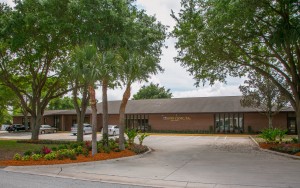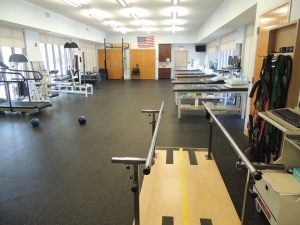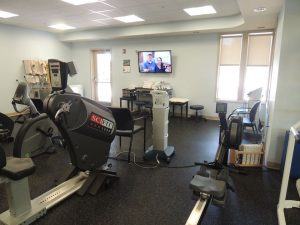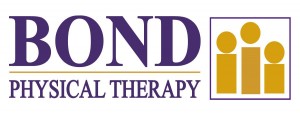NOW Offering Two Locations for your convenience!
- Lakeland Complex – 2039 E Edgewood Dr, Ste 130, Lakeland
- East Campus – 3000 Woodmont Ave, Winter Haven
At Bond Clinic Physical Therapy, we provide the highest quality of service by establishing specialized treatment plans to meet the individual needs of patients. Our rehab team includes: licensed physical therapists, licensed physical therapy assistants, athletic trainers, and certified personal trainer/technicians.
Bond Clinic Physical Therapy & Sports Rehabilitation offers and provides treatment of the following:
• Orthopedic post-operative care
• Neck pain
• Back pain, with back programs focusing on workplace redesign, strengthening, stretching, endurance exercise programs, and postural training to prevent and manage low back pain.
• Sprains, strains, and tendonitis of any joint

Physical Therapy Department located at the East Campus
• Pain management through electrotherapy
• Weight bearing and strengthening, stretching, and endurance with home exercise programs; to increase bone mass and bone density. Especially in older adults with osteoporosis.
• Balance and gait training
• Power mobility device evaluations and other assistant devices such as manual wheel chairs or walkers and cane fitting.
• Custom Orthotics, Protective, and Supportive Device assessments and fitting
• Vestibular rehab focusing on most common vertigo disorders.
• Sport/work reintegration with ergonomic redesign; postural training to prevent job/leisure-related disabilities or injuries, including trauma and repetitive stress injuries.
• Return to golf program with assessments of most common injured areas focusing on freq swing faults.
Frequently Asked Questions:
What is Bond Clinic Physical Therapy?
Physical Therapy is the restoration, maintenance, and promotion of optimal physical function.
• Manage of various diagnoses through enhancing physical and functional abilities.
• Restore, maintain, and promote wellness and fitness and quality of life.

Main Therapy Gym
• Prevent the onset, symptoms, and progression of impairments, functional limitations, and disabilities that result from disease, disorders, conditions, or injuries. (APTA)
What do Physical Therapists do?
Physical therapists are experts in movement and function, and in addition to rehabilitating people from injury, they also focus their skills on preventing injury, loss of movement, and post-surgical intervention. The foundation of physical therapy treatment is primarily therapeutic exercise and functional training. This includes educating patients on injury prevention, postural re-education, and exercises that patients can continue on their own with a home exercise program.
What education requirement/ standards do your therapists have?
Physical therapists are required to have a postgraduate professional degree. All states require physical therapists to be licensed. Licensing typically includes passing the National Ph

Main Therapy Gym
ysical Therapy Examination and a jurisprudence (Law) exam. To keep your license in good standing requires continuing education yearly.
Should I take my pain pills before coming to physical therapy?
Everyone deals with pain differently. Unfortunately, physical therapy may increase the intensity of your pain. Taking pain medication before therapy may make your treatment more tolerable. However, you should only take your medication as prescribed and follow all directions/precautions as indicated. If taking for pain medication in connection with a post-op procedure, take 30-45 minutes prior to your appointment.
Will my insurance pay for physical therapy?
Every insurance plan varies in its coverage of physical therapy services. We currently provide services to many common insurance companies and our list of carriers continues to grow. You can contact your insurance carrier and obtain the physical therapy benefit information.
What should I expect on my first visit?
Please plan on coming 15 minutes prior to your appointment to complete your new patient paperwork.
On your initial visit, you will be evaluated by a licensed physical therapist. They will provide you with a complete assessment of your condition. Plan to be with them for 45-60 minutes which will include time to gather a brief history, to better understand your injury. Each patient situation is unique and your plan of care will vary.
We recommend you bring or wear loose, comfortable clothing to allow the greatest ease in movement and to provide access to treat the involved body area. We also recommend you wear or bring athletic shoes for proper support during exercise.
1.) Medical History Review
The physical therapist will go over details with you and confirm what your doctor has stated on your prescription; if there have been any changes in your condition since your last appointment with your doctor.
2.) Physical Examination
• Palpation- touching around the area of the pain/problem. This is done to check for the presence of tenderness, swelling, soft tissue integrity, tissue temperature, inflammation, etc.
• Range of Motion (ROM) – move the joint(s) by the therapist to check for quality of movement and restrictions.
• Muscle Testing- test strength and the quality of the muscle contraction. Pain and weakness may be noted. Often the muscle strength is graded.
• Neurological Screening- test how the nerves are communicating with the muscles, sensing touch, pain, vibration, or temperature. Reflexes may be assessed as well.
• Special Tests- may perform special tests to confirm/rule out the presence of additional problems.
• Posture Assessment- positions the body is in at rest relative to ideal alignment of the body and spine.
3.) Setting Goals for Treatment
The medical history review and the physical examination will help us determine the best course of action for your treatment program. Most evaluations may be easy enough to proceed right away with your treatment program or we may start at your next session.
Goals are set based on each patient’s goals and need to return to full function. Pain is the primary reason most people receive physical therapy. Once the pain has been reduced, other aspects of your treatment program, such as flexibility and improving your ability to complete day to day functions.
During the treatment sessions, we’ll pay close attention to how your body is responding and then adjust as need be. The constant adjustments to your treatment will minimize the risk of injury and make physical therapy very effective.
4.) Ongoing at Home Treatment or HEP
At your first session, we will let you know what to expect in the way of your results, including your time frame for recovery. However, you will also be given a plan of exercises to do at home along with the treatment you will receive from therapy.
Related Articles
When is it time to visit Physical Therapy?
Bond Sports Medicine Department on the sidelines
 Treating you well since 1948
Treating you well since 1948 



